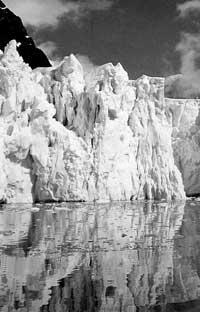Antarctica melts
1997/04/01 Kaltzada, Pili - Elhuyar Zientziaren Komunikazioa Iturria: Elhuyar aldizkaria

The ship MV Artic Sunrise, of the environmental organization Greenpeace, departed last January 17 from the Argentine port of Ushuaia, where it returned on February 15, after almost all the month of research work. The main task of the research expedition was to study the changes that are taking place in Antarctica and it has done so during that time: it has studied in detail the temperature, the structure of the ice plates, the flora and fauna, reaching the conclusions that are collected in the attached map.
This data undoubtedly explains the seriousness of the situation. However, nothing new has been found: the expedition companions who hoped to find this situation before leaving. The document published by the International Committee of Experts on Climate Change in 1995 recognized that “the data collected indicates that the climate is changing and that the influence of human pressure is total.”
This concern was already remembered by many, and in the international meetings held in both Rio de Janeiro and Toronto measures were adopted to channel the situation. Between what was said and what was done, however, too much room has been given. These measures have remained in wet paper. At the end of the year all this will be redirected, with the celebration of the International Climate Conference in Tokyo, to which Greenpeace will transfer the data collected in the foreign work of recent months.
Polar mirror
These symptoms that denounce climate change are easier to suffer at the poles. According to the data provided by the scientists of the British Antartic Survey in 1994, for 130 years, when temperature changes began to be systematically studied, until today, no progressive warming has been observed in Antarctica in recent years.

Temperatures have risen in Antarctica and this trend has remained for several years. As a result, large ice sheets begin to free themselves from the coast, as can be seen in the data provided by Greenpeace. If the temperature of water and air increases, the ice structures will move south hopelessly. In addition, scientists have observed that penguin colonies are increasingly scarce and that the flora is also changing drastically; the presence of species that until now were not seen at the poles is being very high due to the release of seeds that had formerly been “trapped” in the ice, everything points out. The krill that penguins need to survive is increasingly scarce, logically due to the decrease in ice. Obviously, a huge chain will soon be created, at least if it has no longer been launched.
The above are observed changes at the poles themselves. In any case, what is happening in these gigantic peeled masses will directly affect the climate of the entire planet. Changes will not be limited to it.
For example, as the ice recedes, the relationship between the energy that the oceans receive and expand changes, which is known as the albedo effect, and scientists believe that this capacity is being gradually lost, so the seas would lose their ability to absorb CO 2 and heat itself with all that it implies. The sea level will also be affected; the phenomenon is not new, in recent years data have been observed demonstrating the decline of the coast, but everything points to the beginning. What if all the ice sheets of the poles were diluted? It may be an extreme question, but, as we know, reality often surpasses fiction.
In 1991, polar scientist Bill Budd discovered the close relationship between climate change and the thinning of the ozone layer. The continuous production and consumption of gases that increase the greenhouse effect will not benefit the phenomenon already initiated.
There are those who expect little about the summit to be held in Tokyo. Experts approaching will probably not propose new measures to curb climate change, so we will again discuss limiting the use of greenhouse gases or the prohibition of loss or deforestation. No new solutions are expected and no need. Both in Rio de Janeiro and in Toronto these measures were approved, their compliance and implementation is lacking.
The MV Arctic Sunrise sailboat departed for Antarctica on January 17 and left Ushuaia (Argentina) and returned to it on February 15. He spent the whole month in research work. The mission of the trip, which the expedition members had defined day by day, was to study in detail the flora and fauna of Antarctica, to document the signs that demonstrate that climate change is occurring. In 1975 it was the first trip of the MV Arctic Sunrise. Manufactured in Norwegian shipyards, it sailed until its acquisition in 1995 by Greenpeace, Polarbjorn. Greenpeace members knew the ship well, as before buying it was used by the French army in the project to build a runway in Antarctica and then Greenpeace activists chained themselves to Polarbalín as a protest. The research trip of the month was attended by 30 people: crew members, drivers of the two helicopters traveling, campaign coordinators, members of the scientific team and journalists.

Gai honi buruzko eduki gehiago
Elhuyarrek garatutako teknologia






